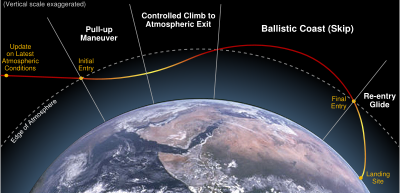
Skip reentry
Encyclopedia

Atmospheric reentry
Atmospheric entry is the movement of human-made or natural objects as they enter the atmosphere of a celestial body from outer space—in the case of Earth from an altitude above the Kármán Line,...
technique involving one or more successive "skips" off the atmosphere to achieve greater entry range or to slow the spacecraft before final entry, which helps to dissipate the huge amount of heat that is usually generated on faster descents. The range modulation made possible by skip entry allows a spacecraft to reach a wider landing area, or to reach a designated landing point from a wider range of possible entry times, which is especially important in abort situations. Like aerocapture
Aerocapture
Aerocapture is a technique used to reduce velocity of a spacecraft, arriving at a celestial body with a hyperbolic trajectory, in order to bring it in an orbit with an eccentricity of less than 1. It uses the drag created by the atmosphere of the celestial body to decelerate. Only one pass in the...
, skip reentry requires precise guidance. An overly shallow entry angle will result in the spacecraft retaining too much of its velocity, possibly escaping into space permanently if this is more than escape velocity
Escape velocity
In physics, escape velocity is the speed at which the kinetic energy plus the gravitational potential energy of an object is zero gravitational potential energy is negative since gravity is an attractive force and the potential is defined to be zero at infinity...
. An overly steep entry, on the other hand, results in more intense heating and stress that could exceed the design limits of the spacecraft, potentially destroying it.
The basic concept is to 'clip' the atmosphere at such an angle that the craft is 'pushed' back out into space, conceptually similar to a pebble skipping across the surface of a lake. Each time, the craft's velocity is reduced so that it can eventually drop into the atmosphere at a low suborbital velocity.
In theory, any craft could perform skip re-entry as it does not require much lift, but in practice it requires precise guidance. Although the space shuttle is capable of skip reentry, NASA has carried it out only in computer simulations (Scott Horowitz, NASA interview, Jan. 25, 2007). It is unclear how thermal shielding would fare under the rapid heating, cooling and reheating. In theory STS-107
STS-107
-Mission parameters:*Mass:**Orbiter Liftoff: **Orbiter Landing: **Payload: *Perigee: *Apogee: *Inclination: 39.0°*Period: 90.1 min- Insignia :...
might have survived if a skip trajectory had been attempted - giving more time for heat dissipation - but this cannot be proven.
Skip entry was first imagined in the 1930s, when a suborbital skipping trajectory was planned for the German Silbervogel bomber, which never flew. The technique was used by the Zond
Zond program
Zond was the name given to two distinct series of Soviet unmanned space program undertaken from 1964 to 1970. The first series based on 3MV planetary probe was intended to gather information about nearby planets...
series of circumlunar spacecraft, which planned for one skip before landing. Zond 5
Zond 5
Zond 5, a formal member of the Soviet Zond program and unmanned version of Soyuz 7K-L1 manned moon-flyby spacecraft, was launched from a Tyazheliy Sputnik in Earth parking orbit to make scientific studies during a lunar flyby and to return to Earth....
, Zond 6
Zond 6
Zond 6, a formal member of the Soviet Zond program and unmanned version of Soyuz 7K-L1 manned moon-flyby spacecraft, was launched on a lunar flyby mission from a parent satellite in Earth parking orbit...
, Zond 7
Zond 7
This article was originally based on material from ...
and Zond 8 made successful skip entries. The Apollo Command Module, when returning from the moon, was capable of a one-skip entry. The Orion spacecraft crew module will be capable of skip entry, to allow targeting the landing site from a greater variety of abort trajectories.
Guidance of a skip trajectory can be tricky due to trajectory sensitivity. The Apollo Skip Guidance was engineered, but never utilized in a manned mission. More recent work relies on advances in computing technology to compute a trajectory onboard the vehicle.

